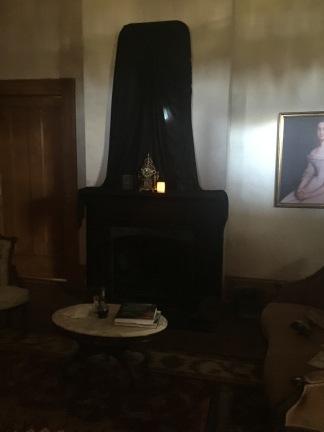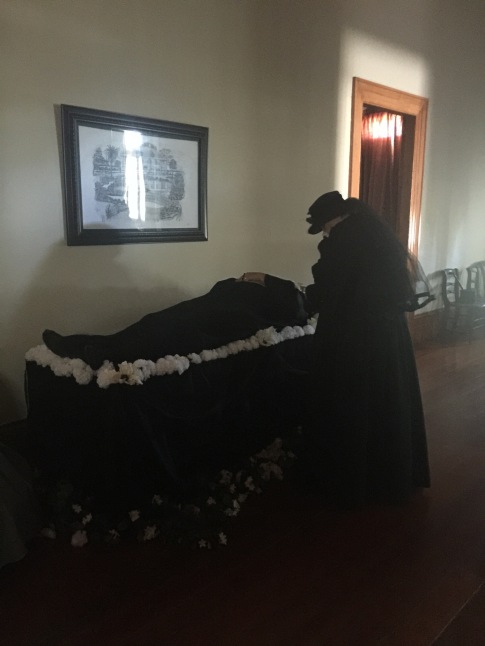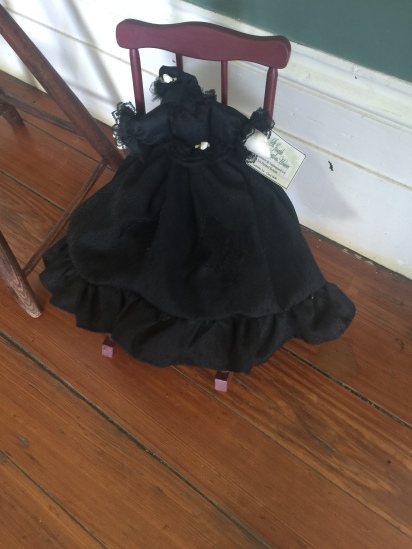When you write mysteries, you tend to gravitate toward the macabre, which is how I ended up on the Creole Mourning Tour offered by St. Joseph Plantation in Louisiana. It was fun to experience a really good living history tour, as opposed to the lame one foisted upon Maggie Crozat and her co-workers by an obnoxious new boss in my latest Cajun Country Mystery, A Cajun Christmas Killing.
The St. Joseph tour offered fascinating insights into the Creole customs and superstitions surrounding death. It helps that it’s the rare plantation still in family hands, so a lot of the information has been passed down through generations. Maureen Gilly, St. Joseph’s general manager, is the great-great-great-granddaughter of Joseph Waguespack, who bought the plantation in 1877. She introduced the tour, and then turned it over to a cast of re-enactors who wove history into their characterizations.
As I went from room to room, I was welcomed by grieving family members of the deceased, a Dr. Cazemir Bernard Mericq who lived at the plantation prior to the Civil War. Genuinely a good doctor, he didn’t discriminate, tending to both the manor house and enslaved residents. So his death was truly a loss to his wife, daughters, and other family members.
There were more funereal factoids than I can remember, but here are a few that stayed with me…
* All clocks in the household were stopped at moment of death as a mark of respect for deceased, for whom all time has stopped.
* Every mirror was covered with black cloth because shiny surfaces attracted spirits.

* The deceased was loaded into the horse-drawn hearse feet-first so that the spirits couldn’t make eye contact with the mourners, thus dooming them. Another theory was that if the spirit of the departed could look back at the house, it might decide not to leave. (Can you say haunted???)
* Visitation of the deceased took place at home for tradition’s sake, but also because given the lack of medical knowledge, there was always the chance he or she wasn’t actually dead. So keeping the resumed-departed out of the ground for twenty-four to forty-eight hours provided at least some insurance against being buried alive.

* There were strict rules about the length of time to mourn, from widows down to workers. And the length of time spent in mourning was much longer for women than men. (Why is that no surprise?)

* There were also rigid rules regarding mourning apparel. For the first six months, a widow’s garments could only be made from a flat black fabric. After six months, the fabric still had to be black, but it could be shiny. After a year, she was allowed to segue into gray or lavender garments. Jewelry was restricted to materials like onyx and wood, or featured designs woven from the deceased’s own hair.
* Even dolls went into mourning.

Of all these rituals, I think the only one I’d embrace is covering the mirrors with black cloth – at least until I hit my Weight Watchers goal weight.
Like I mentioned, the St. Joseph tour offered a wealth of history regarding Creole mourning practices. I hope I got the traditions I shared right. If not, I hope the spirits don’t hunt me down to offer corrections.
Readers, are there any mourning rituals from other cultures that you find interesting?








I guess I’m enough of a rebel that the idea of having to wear certain things to “properly” show mourning bothers me. However, I think our society today tries to move past mourning too quickly. Can’t there be a middle ground somewhere?
LikeLiked by 4 people
Excellent point, Mark.
LikeLike
Agreed! They took it to extremes. I’ve always found the Jewish approach a good middle ground. The burial takes place with 48 hours, then the family sits Shiva for three days or more, depending whether they’re Reform, Conservative, Orthodox, etc. There’s an unveiling at the gravesite a year later, and mentions at services in between. That’s as much as I know, but it’s very respectful without overkill
LikeLike
The idea of ritualized, formal mourning (as opposed to just being sad in private) is so interesting. Glad we don’t have to do all that — but what a fascinating idea for a tour!
LikeLiked by 2 people
Sooo interesting. I should have recorded it. Here’s hoping that I get to write more books because it gave me some great ideas!
LikeLike
Great pics and info, Ellen! I love historical costumed tours — have enjoyed tours in Jamestown and Natchez, but none in Louisiana yet!
LikeLiked by 2 people
Thanks, Vickie!!
LikeLike
Also surprised to learn lavender is a step-down mourning color — I’ve always thought of it as a cheerful shade!
LikeLiked by 3 people
Me too. Also find the rules about sheen of the fabric to be interesting–flat instead of shiny, wow! That’s serious.
LikeLiked by 2 people
It was a gray-lavender, but that could also be because the fabric had aged over the centuries.
LikeLike
Oh my goodness, I love all the pictures! Thank you for sharing, Ellen…it’s fascinating.
Made me think of a short story (can’t remember the title) where the main character’s job is to listen for bells…bells rung by the people who have been buried alive and wake up to find themselves six feet under. Eeeeek.
LikeLiked by 2 people
And then there was that telephone installed in a grave for the same purpose–was that a Hitchcock show or movie?? I think I’ve read about people having actually done this.
LikeLiked by 1 person
It sounds like a wonderful and intriguing tour, and I really enjoyed their pictures. Is the St Joseph Plantation known for having any ghosts/spirits?
LikeLiked by 2 people
Every plantation, at least in Louisiana, has them, Celia. They talked about it on the tour, but I lost that story among all the other details.
LikeLike
Yikes, sounds like a very sobering tour–and what if the deceased was NOT beloved? Couldn’t help but notice the poor dolly–a reminder that children were very often among the dearly departed.
LikeLiked by 1 person
Actually, that was something else I learned on the tour that I didn’t share in this post because it was too disturbing. Photography started in the 1840s, but taking a picture took forever. So Victorian-era folk took to photographing the dead… because they’d stay still. This was particularly true of children – also if they were very, very sick. There was a picture of a couple with a toddler in the a chair between them that was an example of this. I couldn’t bring myself to include it.
LikeLiked by 1 person
Its interesting about the covered mirrors, since that is a Jewish tradition as well. Not because of spirits, but because the mourners should not be thinking of themselves and their appearances. Mourning is considered a time of introspection and the seven day mourning period a time for mourners to feel comforted by the community. I like the custom of stopping the clocks. In many Victorian ghost stories they mention the clocks always stopping at the time of death.
LikeLike
I’d heard/read about the clock and mirrors thing somewhere. The last home visitation we had in the family was when my mother’s grandfather passed away circa 1931. It’s my understanding they still do wakes at home in Ireland.
LikeLike
It’s fascinating that a wake’s partial purpose is to make sure the person isn’t actually “awake.”
LikeLiked by 1 person
That’d explain the fiddle music.
LikeLiked by 1 person
LOL!
LikeLike
You and Marla make me want to go on a tour!
LikeLiked by 1 person
You should! They’re such a break from everything else. AND inspiring. I have a great idea for a Cajun Country Halloween-themed book, should I get to write more of them.
LikeLike
Fascinating post and wonderful photos!
LikeLiked by 1 person
Thank you so much! Glad you enjoyed it.
LikeLike
We also don’t say the decedent’s name for 3 days after they pass…as to not call them back when they are supposed to cross over
LikeLike